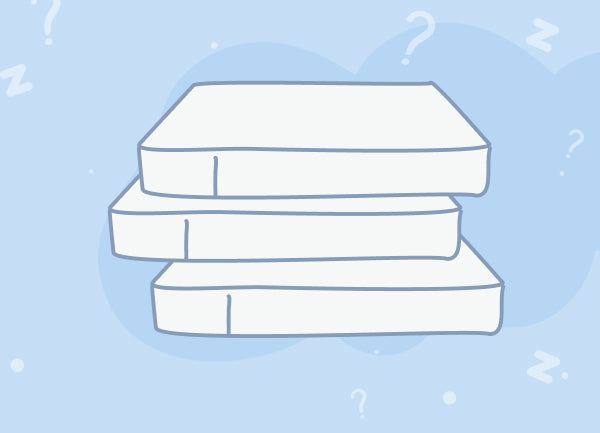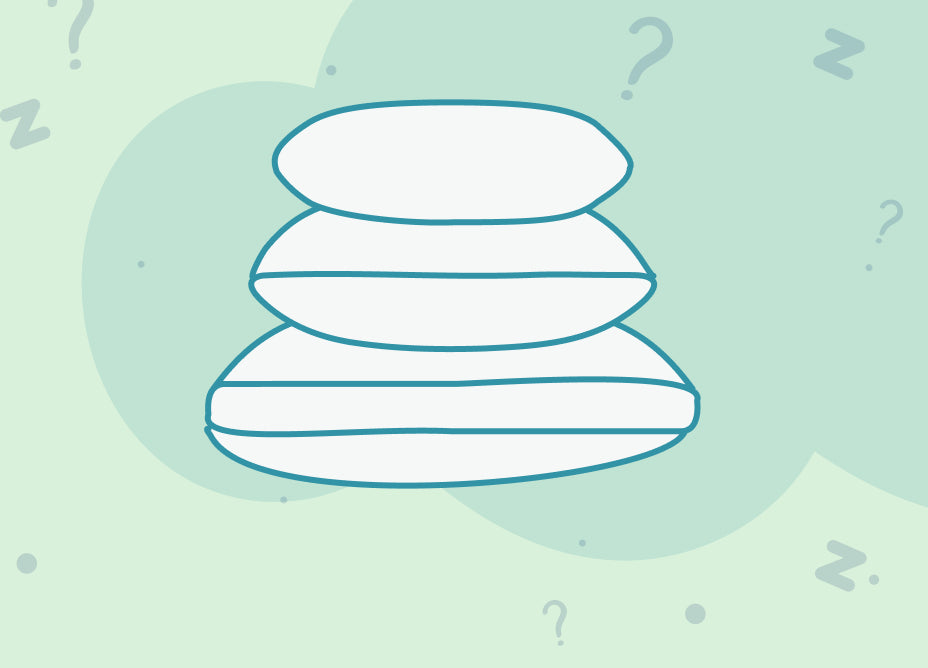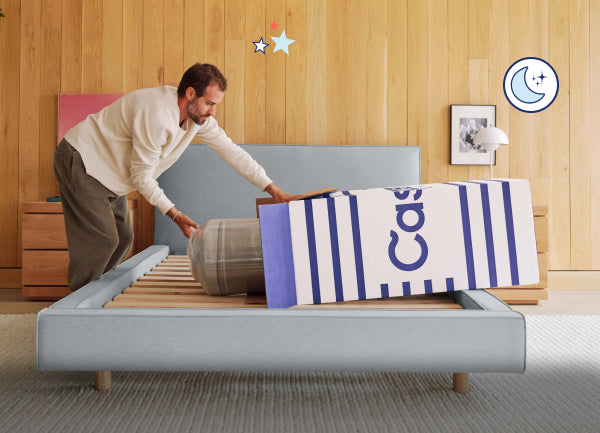The mattress firmness scale is a 1–10 rating system, with 1 being the softest and 10 being the firmest.
Goldilocks may have gotten it right when she tested three beds before finding one that felt “just right.”
But with work demands and family obligations (to say nothing of life’s sneaky way of intervening), most of us want to have a solid understanding of what constitutes mattress quality before we set out shopping for a place to rest our heads.
Breathability, durability, stability, support, and certifications all factor into a rejuvenating night’s sleep. And yet, few things are more critical to your comfort than a mattress’s firmness.1
Let Casper be your guide. Below, you’ll find all you need to know about the mattress firmness scale so that you can land on your own “just right.”
What is Mattress Firmness?
“Mattress firmness” is precisely as it sounds: It refers to a mattress’s level of hardness and softness.2
Selecting what feels best may seem like a wholly individual decision. After all, some people are naturally drawn to a plush mattress; others to a harder, firmer bed.
Personal preference surely plays into choosing between a plush vs firm mattress. However, if you hope to maximize the restorative powers of sleep, you might want to take your overall well-being into account as well.
Sleeping experts indicate that you should weigh the following when selecting your mattress’s firmness3:
- Body weight and type – We all have a different perception of firmness (a fact you may have realized if you’ve ever gone bed shopping with your significant other). This is subjective, surely, but it’s also due to body size and type. A person who weighs more than you may view a bed as considerably softer than you might, simply because they’ll sink deeper into it. Indeed, lighter-weight sleepers may perceive the same bed as “firm” because they won’t compress the mattress’s materials as much. The Sleep Foundation suggests following this framework, which, while not flawless, can provide some guidance on which type of mattress is best for your body:
- Lighter-weight sleepers: Sleepers less than 130 pounds
- Average-weight sleepers: Sleepers between 130-230 pounds
- Heavier-weight sleepers: Sleepers who weigh over 230 pounds
- Sleeping position – Your favorite sleeping position (or at least the one you tend to fall into night after night) might also influence your decision. Generally speaking, the best mattress for side sleepers is a medium-firm mattress that offers pressure relief and contouring, such as the Casper One memory foam mattress—a medium-firm design that supplies bounce and responsiveness. Meanwhile, back sleepers may find much to love about medium to medium-firm mattresses, stomach sleepers ought to opt for a firm mattress, and combination sleepers might discover their best night’s sleep on a medium to medium medium-firm surface.
- Personal preference – Last but certainly not least, personal preference does make a difference. Some people love nestling into a bed that feels like an embrace. Others might like the cool, soothing feel of a mattress that, so to speak, stays in one place throughout the night.
How Mattress Firmness is Measured
Mattress firmness level is frequently measured on a scale from 1 to 10, with 1 coming in as the softest and 10, as you guessed it, the firmest. While it can be a helpful resource—particularly given the subtleness between some models—bear in mind that there’s no universal standard.4 Some manufacturers and review websites choose to create their own measurement systems for mattress firmness.
That said, if they do adhere to the mattress firmness scale (or some variation of it), it can give you a good idea of what type of mattress to search for before making a purchase.
How We at Casper Measure Our Mattress Firmness Levels
Across the mattress industry, there are a myriad of tests that are used to characterize firmness. We narrowed that down to one main test that we use to assess mattress firmness here at Casper, and two tests that we use to characterize components like foam and springs. As a side note, we received Consumer Reports’ mattress test methods, and they use EN1957 for their ratings. Here are the following tests we use at Casper:
EN1957 – Measures overall mattress firmness
- A European standard that measures firmness by pressing into the mattress and measuring the slope of the load-deflection curve at three forces, 210N, 275N, and 340N. This is translated to a rating from 1 (firmest) to 10 (softest). The standard does not, however, provide definitions for what constitutes a firm vs medium vs soft mattress. In addition, the measurement scale is backwards for most Americans, who generally refer to 1 as soft and 10 as firm (see scale in image below).
- At Casper, we generally define firm as from 1-3, medium firm as 3-5, medium as 5-7, medium-soft as 7-8, and soft as 9-10.
ASTM D3574 Test B1 – Measures the firmness of individual foam layers
- Calculated by compressing a 4” x 15” x 15” block of foam and measuring the force, in pounds, required to compress to 25% and 65% of its original height. The force to compress 25% is what is used to specify layer firmness, and is referred to as IFD (Indentation Force Deflection). The ratio between the 25% and 65% forces is known as the “sag factor” or “support factor” and is a good metric for a foam’s resilience and bounciness.
- At Casper, we generally use foams that are 6-25IFD in the comfort layers and 27-50IFD in the support layers.
ASTM F1566 – Measures the firmness of coil (innerspring) unit
- Compresses the coil unit by 3” in 0.5” increments and measures the force in pounds at each increment. Measurements are added together to yield a force rating at that location; the average of three measurements at several points along the center of the coil unit gives the overall firmness rating.
- At Casper, we use slightly firmer coils in our hybrid models, which in our testing, provide a good blend of support and comfort for a wide range of sleepers.

The Mattress Firmness Scale Breakdown
A mounting body of evidence shows that a sound night’s sleep is key to health and wellness. Not only does it boost mood and enhance cognitive performance, but it’s also essential to maintaining a robust immune system.5
Understanding the distinctions on the mattress firmness scale may help you obtain the revitalizing rest you need. Here goes:
Extra Soft Mattress (1-2)
An extra soft mattress measures in between 1 and 2. Designed to cater to people who crave an ultra-plush, cloud-like feeling, they offer a substantial amount of sinkage.
- Pros – Extra soft mattresses may be ideal for those who adore that “hugging” feel just mentioned, as well as lighter-weight sleepers who won’t fall into the depths of the bed. Indeed, an extra soft mattress may provide lighter-weight sleepers with the perfect balance between cushion and contouring.
- Cons – Heavier-weight sleepers might want to shy away from extra soft mattresses, especially those who are dealing with mobility issues: the lack of firmness may result in poor spinal alignment. Over time, this can lead to joint and back pain. Also, extra soft mattresses may deteriorate at a faster pace than their firmer mattress cousins.
Soft Mattress (3-4)
Soft mattresses strike that sweet spot between super plush and solid.
- Pros – Searching for noticeable contouring? A soft mattress might be your jam. They supply a gentle, cradle-like feel for lighter-weight sleepers who tend to slumber on their side. Why? The softness may ease their joints.
- Cons – Similar to extra soft mattresses, soft mattresses that fall between 3 and 4 on the mattress firmness scale may need to be replaced more often—again, due to their materials.6 They might not be the best choice for heavier-weight sleepers, or those who snuggle down on their stomachs.
Medium Firm Mattress (5-6)
Medium firm mattresses, like the Dream hybrid memory foam mattress, are one of the most popular beds on the market. Sometimes referred to as “luxury-firm mattresses,” they provide less sinkage than their softer siblings. They’re also suitable for a broad array of body types.7
- Pros – Medium firm mattresses perform double-duty: They cradle to your body, which may help keep your spine optimally aligned. At the same time, they offer superior breathability because they don’t cling to the body as snugly as extra soft and soft mattresses.
- Cons – Happen to sleep on your stomach? You may need additional support: A medium firm mattress may cause your hips to dip, which can trigger lower back pain.
Firm Mattress (7-8)
Firm mattresses have less bounce and “liveliness” than those that precede them on the mattress firmness scale. This isn’t a negative thing: indeed, a recent survey conducted by Better Sleep Council found that 51% of consumers prefer “firm” or “very firm” mattresses.8
- Pros – One of the biggest benefits of firm mattresses is that they help keep your body well-aligned throughout the night. Heavier-weight sleepers may also find that a firmer surface provides them the support they want. Many firm mattresses are also made with materials that offer a buoyant feel (yes, despite their inherent firmness), such as hybrid beds and innerspring mattresses.
- Cons – If you’re a lighter-weight or side sleeper, a firm mattress may not give you as much, well, give as your body desires; ultimately, this can take a toll on your joints and pressure points.
Extra Firm Mattress (9-10)
Extra firm mattresses offer the utmost firmness. They’re crafted to provide the least amount of sinkage and compression out of all mattresses.9
- Pros – Stability reigns in extra firm mattresses. They follow the natural curve of your spine, which makes them a top choice for stomach and back sleepers. Further, they provide relief to the lumbar spine (or the lower region of your spine), and outstanding durability. A hard mattress is also a leading choice for heavier-weight sleepers and those who get uncomfortably hot at night.
- Cons – If you’re among the majority of people who sleep on their sides, an extra firm mattress surface may not provide the plushness your body requires, particularly in the shoulders and hips. What’s more, they have less-than-stellar “motion isolation.” Translation? You might wake up throughout the night if your S.O. is a restless sleeper.

Factors to Consider When Choosing Mattress Firmness
In addition to the three factors discussed above—body weight, sleeping position, and personal preference—you may want to consider the following:
Health Considerations
Alas, even Goldilocks’ dream bed can’t cure all of your problems. But the right mattress firmness may help dial down the symptoms of two common health issues: back pain and arthritis.
If you have back pain, you may benefit most from a medium to medium-firm mattress. These types of beds help distribute body weight and gravity more evenly, rather than creating pressure points on the heavier parts of your body.
If you have arthritis, however, you might want to sink into a softer mattress (or the first three mattresses on the mattress firmness scale). Plusher iterations may take the edge off of your pressure points and put less stress on your joints.
If You Sleep With a Partner
Your partner might be an average-weight sleeper who not only has sciatica but gets up and down throughout the night. You might be a lighter-weight sleeper who sleeps heavily, and wants nothing more than to sink into a pile of clouds after a long day.
Here’s the good news: Neither of you may have to compromise. Medium firm mattresses are famous for providing universal support, while split king beds offer dual-firmness options (which might give new meaning to “my side of the bed”). Learn more about the pros and cons of split king beds in our blog. Additionally, search for a bed that’s received high scores on motion isolation.
Better yet? Go with a hybrid design like The Dream. Created by Casper, it boasts flex coils and a cozy cover—perfect for both snoozing and spooning.
Find Your Perfect Mattress Firmness at Casper
Buying a new mattress is a cause for celebration. But it’s an endeavor that’s bound to be more successful if you have a clear-cut idea of what you need and want. The mattress firmness scale can be a useful guide as you jumpstart the process, no matter if you’re shopping online or hitting up more than a few brick-and-mortar locations.
Consider Casper your all-in-one stop. Begin by taking a quick mattress quiz before checking out Casper’s array of award-winning mattresses. Add awesome bed sheets and bed pillows to the mix for the kind of sleep that makes you say ahhhh.
Discover your dreamiest sleep system with Casper.
Sources:
- Consumer Reports. Mattress buying guide. https://www.consumerreports.org/home-garden/mattresses/buying-guide/#how-can-i-tell-if-a-particular-mattress-is-right-for-me
- Tom’s Guide. How firm should a mattress be? A guide to the different levels and how to pick. https://www.tomsguide.com/reference/mattress-firmness
- National Council on Aging. Understanding the mattress firmness scale: a comprehensive guide. https://www.ncoa.org/adviser/sleep/mattress-firmness
- CNET. The mattress firmness scale: how to find your personal Goldilocks bed. https://www.cnet.com/health/sleep/the-mattress-firmness-scale-how-to-find-your-personal-goldilocks-bed
- NIH News in Health. Good sleep for good health. https://newsinhealth.nih.gov/2021/04/good-sleep-good-health
- Sleep Doctor. Do I need a firm or soft mattress? https://sleepdoctor.com/best-mattress/firm-vs-soft-mattress
- Tom’s Guide. Medium vs firm mattress: which is the best comfort level for you? https://www.tomsguide.com/face-off/medium-vs-firm-mattress
- Bed Times 2021. Better sleep council. http://onlinedigeditions.com/publication/?m=22801&i=704720&view=articleBrowser&article_id=4009139&ver=html5
- Tom’s Guide. 5 benefits of an extra firm mattress, plus our top 3 recommended hard beds. https://www.tomsguide.com/wellness/mattresses/5-benefits-of-an-extra-firm-mattress-plus-our-top-3-recommended-hard-beds














